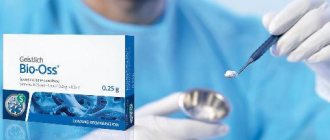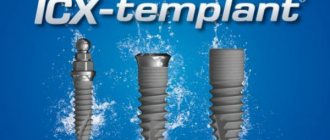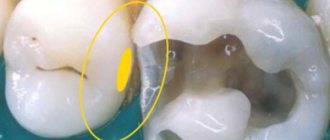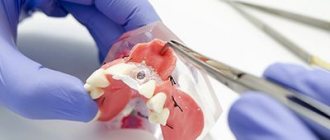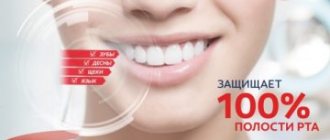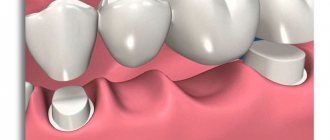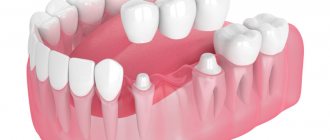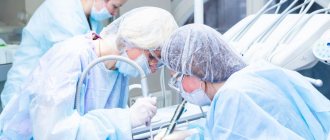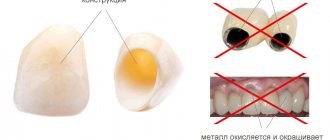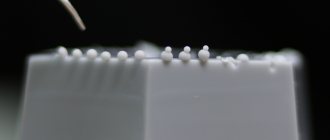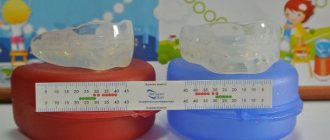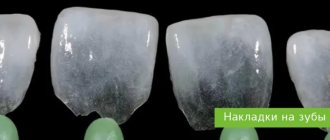One of the sections of scientific dental practice is neuromuscular dentistry. The essence of this section is to study the normal functioning of the muscles and joints of the jaw.
To achieve optimal results in terms of aesthetics and functionality, modern dentists use various methods of procedures. This ensures maximum functionality of the teeth and proper functioning of the jaws. As a result of some research, a decision is made to install an orthotic, which will be discussed in the article.
What is
An orthotic is a dense transparent case that is made of dental plastic that does not react with saliva and does not emit harmful substances. It is placed on the lower jaw in order to correctly position the muscles and ligaments in relation to each other. This is expressed in a change in the position of the jaws.
The result of treatment is the movement of teeth into a given position, and all parts of the dental system should ultimately assume the desired anatomical structure. For this purpose, a removable or non-removable orthotic design is used. The choice depends on the indications, and it depends on the decision of the dentist.
The non-removable structure fixes the teeth motionless, limits the force of the load on the dentition and the articulation of the jaws. Normalization of chewing is observed, and diction does not suffer, which often occurs when using functional equipment. The downside is that the teeth must be prepared before installing a permanent orthotic. A non-removable appliance complicates hygiene procedures and therefore leads to new dental problems more often than a removable one.
A little about neuromuscular dentistry
Neuromuscular or, as it is also called, functional dentistry (NMS) is a whole science that studies malfunctions in the joints and muscles of the dental system. Based on the diagnostic results, industry experts suggest ways to solve the identified problem.
Under a malocclusion we are accustomed to accept the pathological arrangement of teeth. However, a certain violation of the aesthetics of the smile is the last consequence of improper interaction of the jaws.
Modern orthodontists offer to eliminate pathology by wearing various braces.
However, this treatment for malocclusion is incomplete, since disturbances in the functioning of the muscles and joints of the maxillofacial apparatus will not be corrected.
On the contrary, in some cases, artificially created pressure will aggravate the situation and the symptoms of the pathology described above.
Neuromuscular dentistry sets itself more global goals. CMS specialists care not only about the high level of aesthetics of the smile, but also about normalizing the relationship between the dentition, by restoring the proper functionality of the joints and muscles.
In European countries, this industry has existed for many years, but in our country there are still very few qualified NMS professionals.
But, according to experts, many orthodontists will adhere to the principles of work of neuromuscular dentistry specialists in the near future.
Additional information about functional occlusion is presented in the video.
Indications
After a detailed examination, the doctor determines the need to install an orthotic. Most often, the following indications lead to the use of this device:
- grinding teeth at night;
- insufficient function of the temporomandibular joint;
- elimination of dysfunctions of facial and masticatory muscles;
- abnormalities of the joints of the masticatory apparatus;
- replacement of one or more elements of the dentition;
- change in the position of the mandibular bone;
- increasing the height of the bite in the vertical direction.
The duration of wearing an orthotic depends on the clinical picture and personal characteristics of the patient. The approximate period of treatment with an occlusal splint before the start of the course can be given by the attending physician, but these data will be approximate.
Cost of treatment for TMJ dysfunction
Answering questions frequently asked by patients: “How much does treatment for TMJ dysfunction cost, with a discount, at a promotion? Where and how much cheaper are the prices for such turnkey treatment, in Moscow, St. Petersburg or other cities of Russia?”, it should be noted that the price of treatment for pathology and dysfunction of the TMJ jaw joints and the cost of its individual stages depends on the following points:
The cost of diagnosing TMJ dysfunction starts from 10,000 rubles and can reach 80,000 rubles or more. The price of treatment starts from 15,000 rubles and can reach 300,000 rubles or more.
- From the complexity of diagnosis and the number of medical procedures
- From the qualifications of gnathologists, orthodontists and other specialists
- From the pricing policy of each specific dental center
Just pick up the phone and call us!
8
We will definitely make you an offer that you cannot refuse!
Types of structures
Orthodontists distinguish several different types of orthotics. They differ slightly in design and are aimed at eliminating various deviations. Tires are as follows:
- Relaxation . They are used if the patient is diagnosed with stable hypertonicity of the masticatory muscles, which causes dysfunction of the joints.
- Decompression . Aimed at reducing pressure recorded in the posterior or upper parts of the temporomandibular joint.
- Stabilizing . The bite is brought into a state of normal contact between the upper and lower dentition.
- Positioning . Correct the position of teeth within the dental arch.
- Replicating . They are used when the entire row of teeth needs to be moved to the right place.
Like any orthodontic structure, when wearing an occlusal splint, the patient initially feels a certain discomfort, which decreases over time.
The role of the masticatory muscles
The muscles that hold the lower jaw take part in the process of chewing food. They are responsible for raising and lowering it. The joint on which the teeth of the lower row are localized is called the temporomandibular joint (TMJ).
During food processing, muscles produce the necessary amount of energy for this process. If there is too much of it, they relax and return to their original position.
If a person has an incorrect bite, they cannot fully take the starting position. As a result, muscle spasm occurs, and as a result, limited movement of the TMJ.
The functionality of the masticatory muscles can be compared to working out in the gym. When you push yourself to the limit, the next day you find it difficult to move around.
During the continuous process of chewing food, the muscles become clogged with waste, and the jaw cannot open fully. This disorder leads to tooth wear.
Manufacturing
Before making an orthotic for a particular patient, he is sent for X-rays and computed tomography. Sometimes instrumental measurements of anthropometric data are also used. Based on the information obtained, the degree of interaction between the muscles and structures of the temporomandibular joint is determined. This allows you to understand what type of apparatus should be used in this case.
In order to make a design that will suit all parameters and can effectively eliminate the problem, an impression of the lower jaw is made in the dental office. After hardening, the cast is sent to a technical laboratory, where the future structure is modeled using special computer programs. Then the orthotic itself is performed.
The material used to make muscle relaxant splints is hypoallergenic plastic. It has such qualities as strength, elasticity and softness, which allows the soft tissues of the oral cavity to quickly adapt to the new conditions created. During manufacturing, all pathological features that must be eliminated while wearing the orthotic are taken into account. This affects the rigidity of the material, which can be changed, the type of fixing elements, etc.
Center for the treatment of TMJ dysfunction in Moscow
Today, clinics and treatment centers for TMJ dysfunction in Moscow, various forums and patient reviews make it possible to determine the gold standard of effective treatment methods and related equipment that most effectively treats this disease.
The list of necessary diagnostic and treatment equipment used by leading specialized institutions, including the Partner Med clinic, includes:
- Articulators and facebows "Girbach"
- Axiograph "Gamma"
- "Mist Tens" device
- Computer electromyograph "Synapsis"
- Fox osteopathic apparatus
- Computer occlusion analyzers “T-scan”
and some other devices.
The course for the treatment of TMJ dysfunction at the Partner Med dental clinic lasts from 3 to 12 months, depending on the complexity and number of necessary diagnostic and treatment procedures in each specific clinical case.
Operating rules
The average time to wear an occlusal splint is six months. During this period, the muscles acquire new characteristics and are prepared for further treatment. Symptoms of weakening of the temporomandibular joint become less pronounced or disappear completely during this time. This effect is achieved due to a stable reduction in load.
To achieve this result, certain rules must be followed:
- For removable structures, you must follow the wearing regime and do not remove the structure unless necessary. During sleep, it should be left inside the oral cavity, since with hypertonicity, even at night, excessive load on the joint can be observed. This picture especially corresponds to bruxism.
- You must come to your dentist consultation with a splint on your teeth. This is necessary so that the doctor can evaluate the progress or changes that have occurred during the course.
- If there is a gap between the upper and lower teeth, then you cannot try to remove it by pressing on the lower jaw. Such forcing can lead to negative consequences. The dental arch needs time to acquire the desired shape.
- Removable structures must be stored in a special container with solution. This is necessary to keep the structure soft and elastic. In addition, the container will protect the orthotic from mechanical damage and contamination.
- When brushing your teeth, the occlusal splint is also cleaned. To do this, use regular toothpaste. It is prohibited to place the structure in hot water, as high temperatures can deform it.
- During the course you should visit your doctor at the prescribed intervals. This will allow you to detect all changes in a timely manner and, if necessary, adjust the treatment plan. Sometimes it is necessary to remove a layer of plastic or, conversely, add thickness to add rigidity.
Reviews
Nadezhda Galyan:
“My daughter had severe bruxism, which appeared due to hypertonicity of the masticatory and facial muscles. At first she was prescribed medication, but it did not alleviate the situation. I was very worried because my teeth began to wear out. The dentist advised me to try an orthotic. My daughter wore it for a year - from 12 to 13 years old. “In the end, the problem was solved, the upper edges of the teeth were restored, and now everything is fine.”
Lydia Torshina:
“At the very beginning of the course, I regretted that my daughter was prescribed a removable orthotic, but then I realized that in our case it was more convenient. She didn’t take it off when not needed, but I could clean this mouth guard myself. My daughter often doesn’t finish brushing her teeth, so using a non-removable appliance could cause damage to her teeth.”
Restorative therapy
To eliminate pathological abrasion of hard dental tissues, it is necessary to carry out treatment in three directions. To begin with, provoking factors are eliminated, after which the missing bone volumes are restored and the interdental relationship is normalized. Minor manifestations of pathology are eliminated by wearing night guards. The chewing muscles relax and tooth friction is eliminated.
Before starting all procedures, it is necessary to make a diagnosis. To make an accurate diagnosis, the Implantmaster clinic has technology (images are more accurate, and X-ray radiation is even less), the ability to take a panoramic image of all teeth and targeted radiography of a specific unit.
In severe cases of erasure, the following methods are used:
- Placement of crowns. It would be optimal to install metal-ceramic crowns for molars, which restore the natural shape of the crown and restore functionality when chewing. Installation of all-ceramic crowns made of zirconium dioxide is recommended for the front teeth.
- Stump inlays are used in case of large destruction of the crown part of the tooth. They accurately follow the shape of the root canals and give the tooth a margin of safety.
- Microprosthetics with veneers. Such prosthetics will protect not only from pathological abrasion, but also provide an aesthetically pleasing smile.
